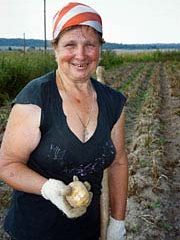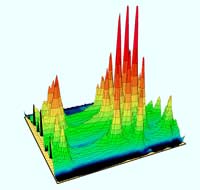
A new model of mid-ocean ridge propagation: Introducing the process zone
The site of extensive volcanic activity and sea-floor spreading, the Galapagos Rise in the eastern equatorial Pacific Ocean has yielded groundbreaking research results for the field of plate tectonics. Jacqueline Floyd and her colleagues, all of Columbia University’s Lamont-Doherty Earth Observatory, are introducing a new model for the process of mid-ocean ridge propagation (lengthening), which is responsibl

While many Americans will be relaxing after their Thanksgiving Day feast, many people around the world may have a shortage of food, particularly potatoes, a staple that is being seriously threatened by a disease called potato late blight.
In a news story appearing in the journal Science (Nov. 29), “Taking the Bite Out of Blight,” writer Glenn Garelik examines the disease that is affecting potato production globally.
Potato late blight (Phytophthora infestans ) is the pathogen tha

Study opens door for faster, simpler methods of measuring carbon nanotubes
Building upon this summer’s groundbreaking finding that carbon nanotubes are fluorescent, chemists at Rice University have precisely identified the optical signatures of 33 “species” of nanotubes, establishing a new methodology for assaying nanotubes that is simpler and faster than existing methods.
In research published this week by Science magazine, a spectroscopy research team led by Rice Chem

A new study, just published in the journal Science, shows for the first time that some bacteria that cause diseases in humans use molecular hydrogen as an energy source. The research could point the way toward new treatment regimens for everything from ulcers and chronic gastritis to stomach cancer.
Microbiologists at the University of Georgia worked specifically in mice with the gastric bacterium Helicobacter pylori, a pathogen that colonizes the mucosal surfaces of the human stomach and g

An accepted assumption in astrophysics holds that it takes more than 1 million years for gas giant planets such as Jupiter and Saturn to form from the cosmic debris circling a young star. But new research suggests such planets form in a dramatically shorter period, as little as a few hundred years.
The forming planets have to be able to survive the effects of nearby stars burning brightly, heating and dispersing the gases that accumulate around the giant planets. If the process takes too lo

VLT Interferometer Measures the Size of Proxima Centauri and Other Nearby Stars [1] At a distance of only 4.2 light-years, Proxima Centauri is the nearest star to the Sun currently known [2]. It is visible as an 11-magnitude object in the southern constellation of Centaurus and is the faintest member of a triple system, together with Alpha Centauri, the brightest (double) star in this constellation. Proxima Centauri is a very-low-mass star, in fact barely massive enough to bu

– new calculation confirms standard model of particle physics. Contribution of hadronic vacuum polarization determined with unprecedented accuracy. The magnetic moment of the muon is an important precision parameter for…
Technique may prevent formation of unwanted waves that siphon off needed energy. Heating plasma to the ultra-high temperatures needed for fusion reactions requires more than turning the dial on a…

An international team of astronomers, led by researchers from the Astronomical Observatory of the University of Warsaw, have identified a new class of cosmic X-ray sources. The findings have been…

Antibody that Neutralizes Inhibitory Factors Involved in Nerve Regeneration Leads to Enhanced Motor Function after Acute Spinal Cord Injury. Researchers at 13 clinics in Germany, Switzerland, the Czech Republic and…

How the body’s natural killer cells could fight leukemia. Every year, some 13,000 people in Germany are diagnosed with leukemia. Despite intensive chemotherapy, around one in two of them die….

… eco-friendly reactor converts air and water into ammonia. Producing enough ammonia to feed the world comes with a large carbon footprint;. process described in new UB-led study could help…

How simulations help manufacturing of modern displays. Modern materials must be recyclable and sustainable. Consumer electronics is no exception, with organic light-emitting diodes (OLEDs) taking over modern televisions and portable…

“Neurons that fire together, wire together” describes the neural plasticity seen in human brains, but neurons grown in a dish don’t seem to follow these rules. Neurons that are cultured…

The quest for sustainable energy solutions has been a major focus of scientific research for decades. Solar energy, a clean and renewable source, has emerged as a promising alternative to…

With a processing speed a billion times faster than nature, chip-based laser neuron could help advance AI tasks such as pattern recognition and sequence prediction. Researchers have developed a laser-based…

New technology could remotely identify various types of plastics, offering a valuable tool for future monitoring and analysis of oceanic plastic pollution. Researchers have developed a new hyperspectral Raman imaging…

Artificial Intelligence (AI) has established a strong presence across industries, large and small. The “VoBaKI” research project has empowered small and medium-sized enterprises (SMEs) with an innovative tool to independently…